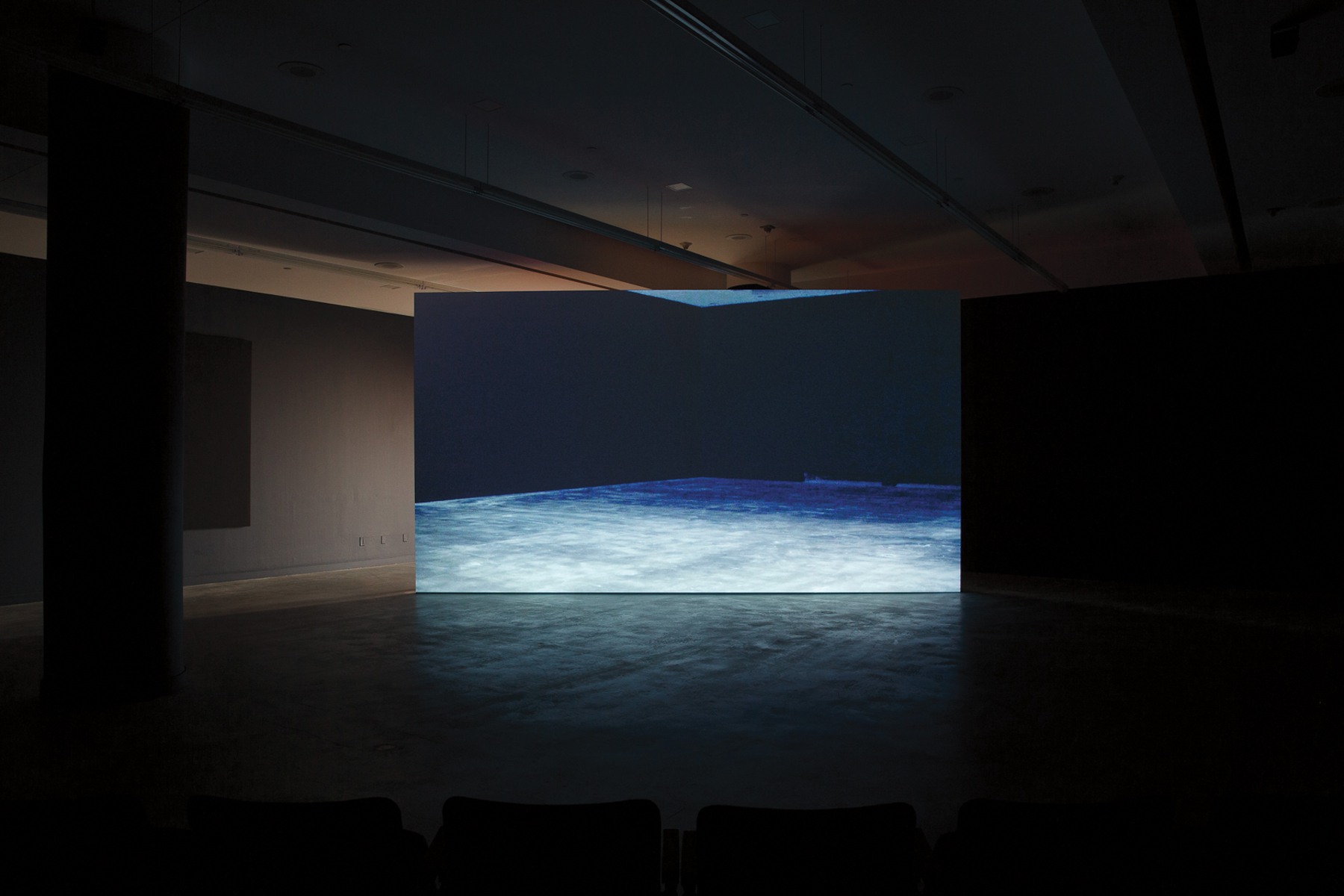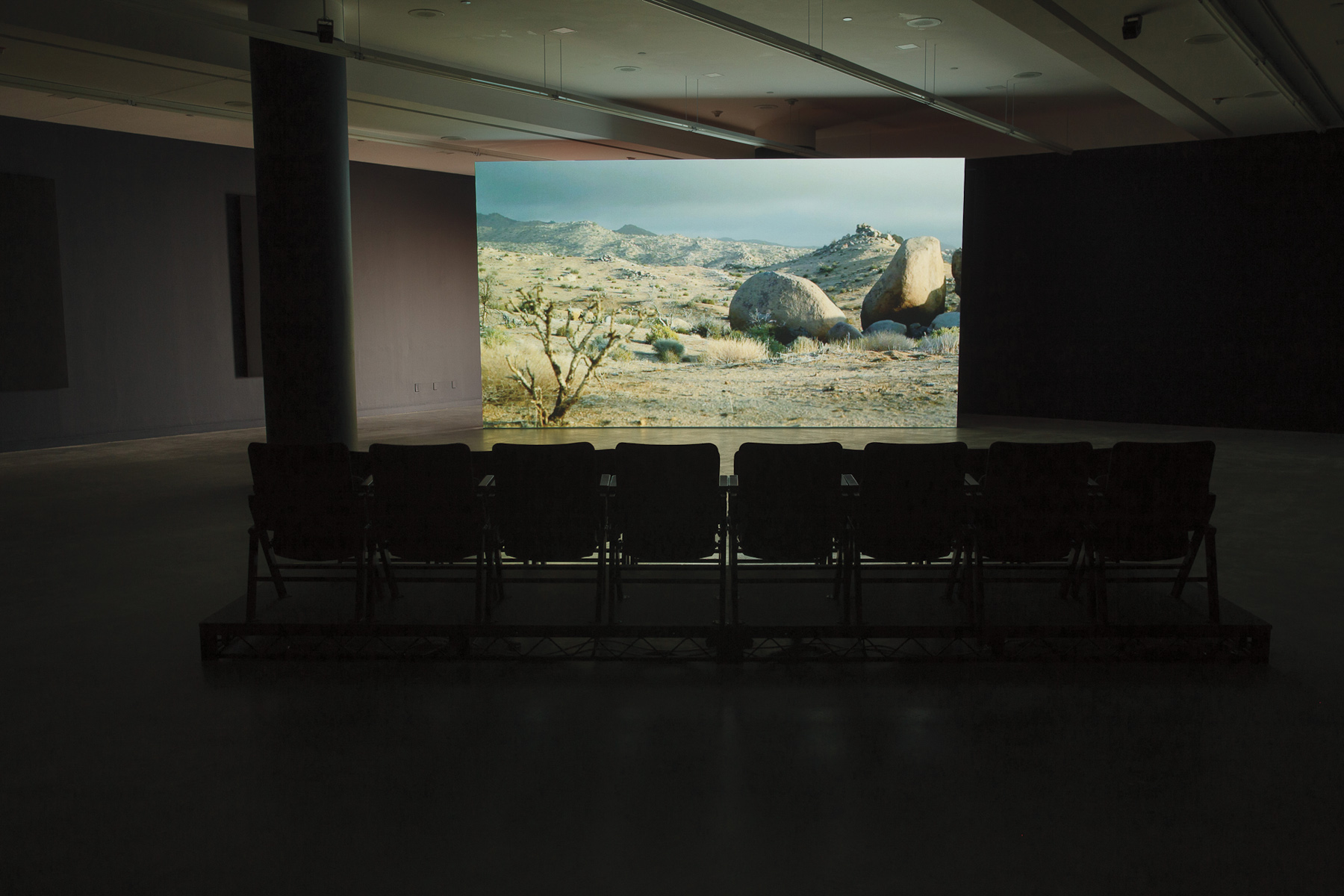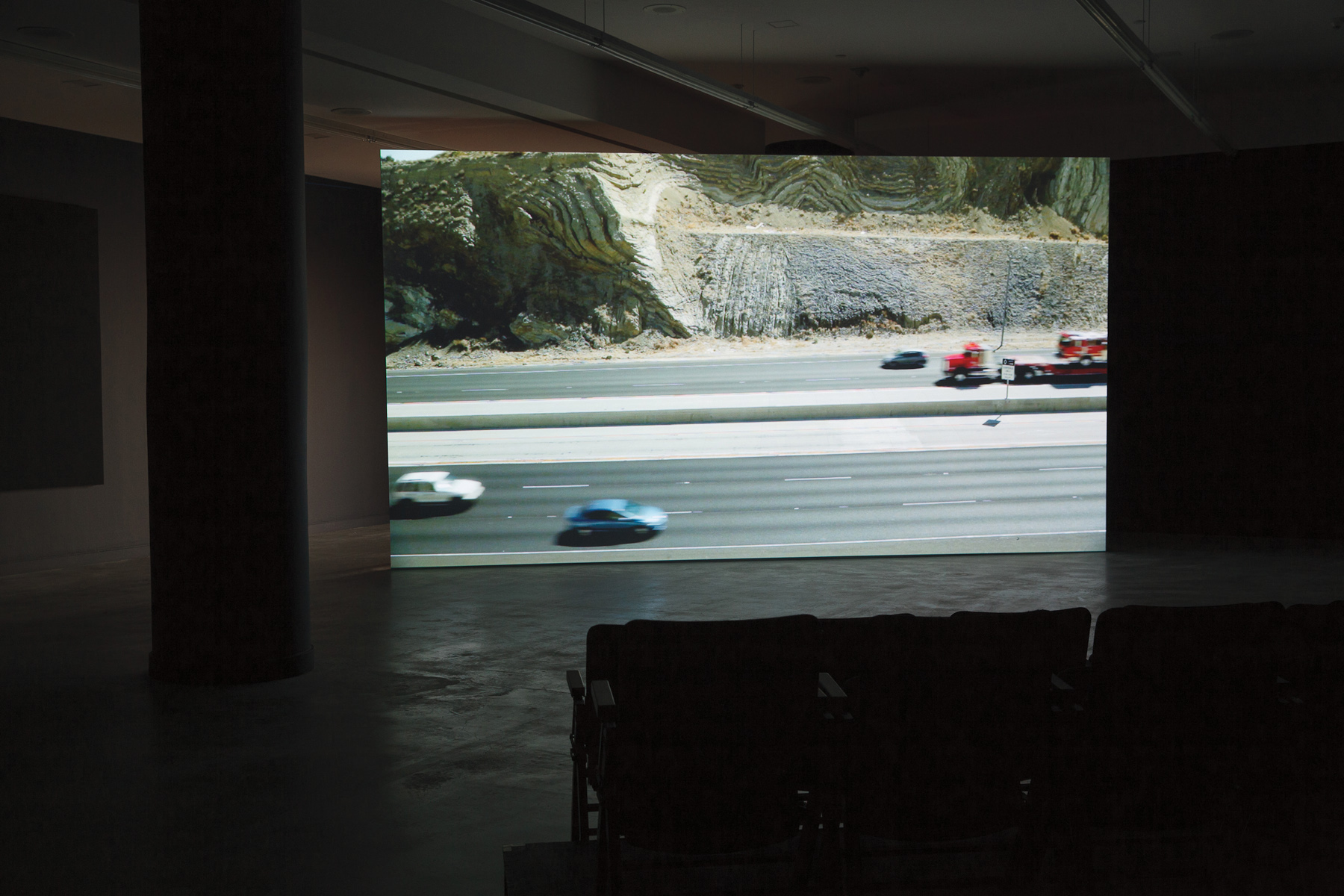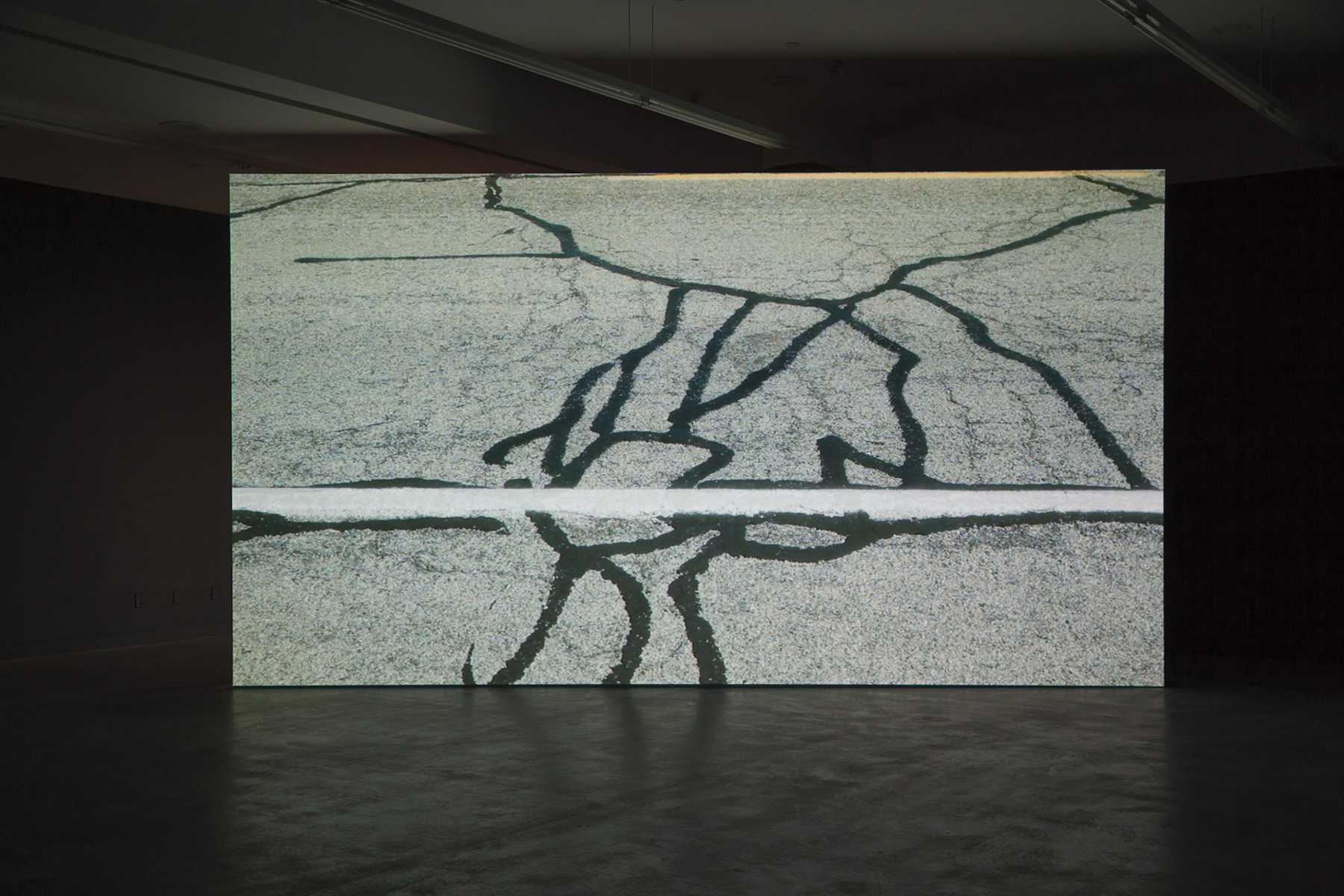The “present” cannot support the cultures of Europe, or even the archaic or primitive civilizations; it must instead explore the pre- and post-historic mind; it must go into the places where remote futures meet remote pasts.
–Robert Smithson, 19681
Shot in Joshua Tree National Park and a downtown Los Angeles parking structure, Medium Earth (2013), the latest film from the London-based art collective The Otolith Group, draws a sharp contrast between extraordinary nature and the prosaic non-spaces of the urban landscape. Observing the rush of cars from the side of a highway or considering the interior of a parking complex for extended periods of time, the film’s pacing seems incompatible with the speed of modern time. Likewise, the sublime and timeless desert landscape seems inhospitable to sustaining human existence.

The Otolith Group, Medium Earth, 2013. Installation view, REDCAT, Los Angeles. Photo by Scott Groller.
Out of synch with modernity and alienated from the natural environment, the film’s voiceover by Anjalika Sagar—one half of The Otolith Group—uses the pseudo-science of Earthquake Sensitivity to cut a fissure between nature and society, organic and inorganic. As described by Sagar, Earthquake Sensitives “hear faults at high frequencies.” Geographical locations correspond corporally to points on the body, with the experience of pain mirroring the buildup of tectonic pressure preceding a seismic event. The voiceover presents a list:
Ear pain is Italy, Sicily, Greece, Crete
Right leg is Peru, Brazil, Colombia…
Washington State can cause sharp heart pains…
Southern California into Mexico causes headaches…2
In playing on the experience of Earthquake Sensitives such as Charlotte King, who gained notoriety for predicting the 1980 Mount St. Helens eruption, The Otolith Group’s reference to the social phenomenon is used ostensibly as a means of “opening a space in which minerals and the inorganic think of us.”3 Whereas landscape and the geological world are normally considered as the static backdrop to human histories, Medium Earth looks to reverse this anthropocentric perspective through posing the question: “Who does the Earth think it is?”4
At least from an ideological standpoint, assuming the position of the landscape is impossible because “we cannot detach our looking from the culturally constructed lenses and frames that make what we see look like what we expect to perceive…”5 In other words, the acknowledgment of an organic and inorganic opposition necessarily implies a historically conditioned split, itself predicated on a set of values that have been ascribed to the different parts of what was once a whole. (The landscape comes into view through the perception of distance; remove the distance and you lose all perspective.) While seemingly all encompassing, the (present) shape of reality is far from absolute. Rather, reality is constantly shifting in the wake of (and to account for) new or previously unseen perspectives. As suggested in the film, the phenomenological dimension (an experience that pushes beyond reason) combined with the rigid structural codes imposed by society together have the potential to produce a third form. The result, in this case, is the Sensitive, who is neither human nor geological matter but perhaps a composite of both. In anthropomorphizing the Earth, both in speed and scale, Sensitives become the medium through which to comprehend (but not answer) the film’s central question, by mirroring it back at us.

The Otolith Group, Medium Earth, 2013. Installation view, REDCAT, Los Angeles. Photo by Scott Groller.
“In 72 hours [they] are 3 million years old,” and as such Sensitives have a special privilege to Earth’s internal drama, “hotter than the surface of the sun” and happening “3000 clicks [km] below the cold crust.”6 What is obscured from our super-terranean existence is revealed to Sensitives as a dynamic world where “faults talk to each other” like “families communicating with other families.”7 And just as in the cultures that this subterranean world supports, these faults “form systems,” “transferring stresses,” “conducting pressure waves, calculating shear waves,” and “orchestrating fissures” in an age-old battle that for us is acknowledged only on the occasion of seismic activity. For the Sensitives, the series of events leading to the Earth’s present shape accelerate to match human time: the Big Bang; the compression of gaseous matter in the solar nebula; the Iron Catastrophe, which created the earth’s molten core; the cooling over time on the Earth’s surface that created the earth’s tectonic plates; and the crust’s struggle over the course of four billion years to repress the Earth’s chaotic interior, which created a layer of stratification thick enough to support the biological life of the present. For the Sensitives, this vast sequence of events must take place in a thirty-five-year time frame, and must likewise appear as chaotic as the transition of an infant into an adult. But in life there is death, and although in this geological context the history of civilization spans the length of a fifteen-minute coffee break, Medium Earth’s radical scale of time is a reminder of the inevitable fate of all matter.
It is now apparent perhaps more than ever that civilization will prematurely fizzle out very shortly in its own human-made ecological catastrophe, becoming yet another layer of stratification in the continually “shifting face of the Earth.”8 In the cosmological perspective, what theorist Robin Mackay refers to as a history of “geotraumatic” events, the destruction of one strata displaces its energy into another form, which later becomes the material (or immaterial) matrix of yet another future form—an evolutionary break (biological, geological, or otherwise) whose genetic code dates back all the way to the Big Bang.9 More than simply a doomsday premonition, Medium Earth is speculative of a future beyond the destruction of mankind. The film implicitly proposes a mutation of ourselves that has already started to take shape through an unfolding catastrophe that challenges the ideological lines drawn between self and nature. This catastrophe produces a third term, a tertium quid: a mutant body set to inherit the future, but for the moment remaining latent, hidden, or repressed.
This theme of a “displaced mutant body” is common to The Otolith Group, whose works take the vantage point of a future space people, born one hundred years from now in microgravity and without the necessary crystals in the ear (called otoliths) needed for maintaining balance on earth.10 Confined therefore to outer orbit, they experience their past (our present now in ruins) through video archives from which they construct essayistic visual narratives. As an artistic practice, distance from the present allows the exploration of unforeseen permutations that have the potential to come to consciousness through breaks in historical continuity. In The Radiant (2011), for example, the Fukushima Daiichi power plant failure and subsequent nuclear fallout become the means through which to speculate on the contamination of unseen radiation as eliciting a future mythology.
The choice of location for Medium Earth, however, suggests The Otolith Group might be interested in the re-territorialization of the former (forgotten or unconscious) spaces of America’s historic frontier. (One scene in particular appears conspicuously close to Ansel Adams’s photograph Mount Williamson, Sierra Nevada, from Manzanar [1944].) Whether hankering after geological origins or the atavistic return to America’s archaic past, the images of a sublime Southwestern landscape in Medium Earth reestablish the promise the “West” once held for an exponential future. These scenes recall a nostalgia for the uncouth madmen who first settled California: the pioneer, the trapper, the frontiersman, the forty-niner, the cowboy, and later the bohemian artist and the hippie, who reclaimed the periphery in their own rejection of the center (their past). Most problematic of all is the association to the mytho-historical Indian, who, through exploitation, genocide, and forced removal, is condemned to an archaic and marginalized existence, only to reemerge in tandem with hippie culture and within 1970s environmental discourse as an anachronistic prophet (read: puppet) from the past, warning us against the destructive consequences of our industrial material culture.
As a Western for a new geological epoch—established along the canonical lines of a confrontation with an alterity that results in the transformation of the self into something other—it’s the unresolved history of America’s traumatic past and troubled relationship with native American culture that provokes the most reflection on what the faults “promise” in Middle Earth, and how these promises differ from, reflect, highlight, reinterpret, conceal, or simply replicate the past promises of the West. In his book, The Return of the Vanishing American (1968), literary critic Leslie Fiedler sought to demonstrate how the transition of European societies into the New World resulted in four topographical myths: the Northern, in which the WASP transplanted to the harsh wilderness becomes the “Yankee” (Thoreau, Frost); the Southern, in which the treatment of the “Blacks” condemns the European to becoming “Whitey” (Caldwell, Capote); the Eastern, in which the desire for the Old World returns the American to a “Tourist” (Henry James, Fitzgerald); and lastly, and the form of most concern to Medium Earth, the Western, in which the encounter with the Indian (“that utter stranger for whom our New World is an Old Home”) transforms the European into becoming an “American.”11
Like the bodies of the Sensitives—on which geotraumatic events play out in aches, pains, and bouts of vertigo—the shock wave of the confrontation with the Other sends cracks through the assurance of self, which the archetypical Western resolves in one of two ways: through transformative or destructive violence. Transformative violence results in the “metamorphosis of the WASP into something neither White nor Red (sometimes by adoption, sometimes by sheer emulation, but never by actual miscegenation).” Destructive violence annihilates the Indian (“sometimes by castration-conversion or penning off into a ghetto, sometimes by sheer murder”) and dispenses with the Western “as a living form, for the West has, in effect, been made into an East.”12
Fiedler’s analysis provides a fine critique of Western time as being “progressive,” in that it takes what it needs from others in order to transcend itself.13 In moments of historical disillusionment with the present, the past—just as uncertain or unstable as the future—can be rehashed, as here in Medium Earth, through the recycling of tropes of the Western. (Kodwo Eshun and Anjalika Sagar established The Otolith Group in one such moment—2002—during the pre-Iraq-war period of “collective uncertainty about the future.”14) As a myth of history inscribed in equal parts fiction and fact, there is a space for reflection on, or even radical reversal of, the ultimately deceiving identities “the West” (in Fiedler’s sense) has produced. Writing in the 1960s, Fiedler saw the baby boom generation reject dominant post-WWII American culture that, through warmongering and the emulation of Europe’s nineteenth-century imperial powers, had become the symbolic “East.” Hippies paradoxically adopted many traditional Western motifs as countercultural signals, only this time in order to enact an inverse narrative to colonialism. The desire of the “freaks” to breech the limit of reason through the aid of psychedelic drugs and the exploration of inner space resulted in the hallucination of histories that melded fantasies of “ancient civilizations founded by extra-terrestrials, or speculation about the imminent rise of the age of the Aquarius” with pseudo-theories of universal biological rhythms that, for those capable of turning on and tuning in, connected everyone to everything.15 The search for a location in which to physically drop out of trad and profane civilization naturally lead to the forgotten spaces of America’s past, where suburban youth sought out Native American communities for spiritual guidance through the ritualistic intake of peyote and other mescaline-producing cacti (“bridges to—even as they are gifts from—the world of the Indian: the world not of an historical past, but of the eternally archaic one.”16) In becoming the hippie, Fiedler claims that the Westerner “cease[s] to be White at all and turns back into the Indian, his boots becoming moccasins, his hair bound in an Indian headband, and a string of beads around his neck—to declare that he has fallen not merely out of Europe, but out of the Europeanized West, into an aboriginal and archaic America.”17

The Otolith Group, Medium Earth , 2013. Installation view, REDCAT, Los Angeles. Photo by Scott Groller.
In this New West, Fiedler saw the true origins of the West, as produced by an internal conflict: the struggle to resolve the past (the culturally constructed identity: the European, the WASP) with the shock of the new and unknown, whether through the exploration of new lands, or the ingestion of psychedelic drugs. This version of the West winds up leading the subject into a chaotic state of madness, culturally threatening while simultaneously generative of the formation of new or altered subjectivities: “We have come to accept the notion that there is still a territory unconquered and uninhabited by palefaces, the bearers of ‘civilization,’ the cadres of imperialist reason; and we have been learning that into this territory certain psychotics, a handful of ‘schizophrenics,’ have moved on ahead of the rest of us.”18
Fiedler’s reading of a regenerative West that continually summons the reappearance of the “vanishing American” appears to radicalize a favorite aphorism of Bill Clinton, in which the former president states that “there’s nothing wrong with America that can’t be cured by what’s right with America.”19 In this view, the West’s self-generative and transformative properties can be elicited in response to the perception of a threat to, or disillusionment with, the current trajectory of America’s path, a path that seems perpetually prone to imitating its former self. (Take, for example, the Tea Party members who live mythically in the ideal fantasies of a past analeptically projected onto the present as a remedy for the ills of modern society.) However, in a culture prone to anachronism and a reinvention of itself through a role-playing of its past, the counterculture using the mytho-historical Indian to revisit the traumatic past of colonialism anew only served to further negate the existence of native American culture within a present tense, producing a further violence and alienation of the Native American from the spatial or temporal landscape of modern American society.

The Otolith Group, Medium Earth, 2013. Installation view, REDCAT, Los Angeles. Photo by Scott Groller.
The radical potential of the pluperfect hypothesis articulated by The Otolith Group is to take apart the structuring oppositions that allow for the deployment of such mythic figures and metaphors. In Medium Earth, this dismantling is implied through the sequence of scenes in which a continuous shot of a crack in an underground parking structure cuts to the exponentially more threatening San Andreas fault line, where the folds and fissures that striate the craggy rocks in the arid Californian desert—desertification being the surest sign of our demise—are followed back to the subterranean parking garage, whose walls now seem helpless against the weight of it all. From another time and place, the tragedy of our slow moving catastrophe appears as if from a great distance, and the destructive transformation of matter into energy seems both inevitable and real. Medium Earth presents the bodies of Sensitives as stand-ins for future strangers, attuned to these vast spaces and times, dissolving or crossing over the ruptures and gaps and, in their embodied cartography, both exceeding and undoing the mythologies of the West.
Robin Selk is a writer and curator living in Los Angeles, California.
